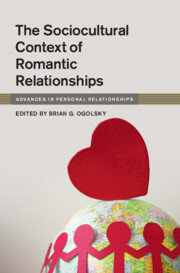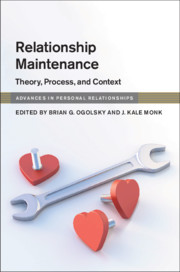22 results
Index
-
- Book:
- The Sociocultural Context of Romantic Relationships
- Published online:
- 19 October 2023
- Print publication:
- 02 November 2023, pp 273-275
-
- Chapter
- Export citation
1 - The Sociocultural Context of Romantic Relationships
-
-
- Book:
- The Sociocultural Context of Romantic Relationships
- Published online:
- 19 October 2023
- Print publication:
- 02 November 2023, pp 1-6
-
- Chapter
- Export citation
Copyright page
-
- Book:
- The Sociocultural Context of Romantic Relationships
- Published online:
- 19 October 2023
- Print publication:
- 02 November 2023, pp vi-vi
-
- Chapter
- Export citation
Contributors
-
- Book:
- The Sociocultural Context of Romantic Relationships
- Published online:
- 19 October 2023
- Print publication:
- 02 November 2023, pp ix-x
-
- Chapter
- Export citation
Contents
-
- Book:
- The Sociocultural Context of Romantic Relationships
- Published online:
- 19 October 2023
- Print publication:
- 02 November 2023, pp vii-viii
-
- Chapter
- Export citation

The Sociocultural Context of Romantic Relationships
-
- Published online:
- 19 October 2023
- Print publication:
- 02 November 2023
15 - Relationship Expectations about the Commitment to Wed
- from Part IV - Interdependence, Timing, and Expectations
-
-
- Book:
- Interdependence, Interaction, and Close Relationships
- Published online:
- 19 June 2020
- Print publication:
- 18 June 2020, pp 316-342
-
- Chapter
- Export citation
Part I - Introduction
-
- Book:
- Relationship Maintenance
- Published online:
- 02 December 2019
- Print publication:
- 19 December 2019, pp 1-12
-
- Chapter
- Export citation
1 - Maintaining the Literature on Relationship Maintenance
- from Part I - Introduction
-
-
- Book:
- Relationship Maintenance
- Published online:
- 02 December 2019
- Print publication:
- 19 December 2019, pp 3-12
-
- Chapter
- Export citation
Figures
-
- Book:
- Relationship Maintenance
- Published online:
- 02 December 2019
- Print publication:
- 19 December 2019, pp x-x
-
- Chapter
- Export citation
Part II - Theories of Relationship Maintenance
-
- Book:
- Relationship Maintenance
- Published online:
- 02 December 2019
- Print publication:
- 19 December 2019, pp 13-106
-
- Chapter
- Export citation
Contents
-
- Book:
- Relationship Maintenance
- Published online:
- 02 December 2019
- Print publication:
- 19 December 2019, pp vii-viii
-
- Chapter
- Export citation
Contributors
-
- Book:
- Relationship Maintenance
- Published online:
- 02 December 2019
- Print publication:
- 19 December 2019, pp xi-xii
-
- Chapter
- Export citation
Part III - Processes of Relationship Maintenance
-
- Book:
- Relationship Maintenance
- Published online:
- 02 December 2019
- Print publication:
- 19 December 2019, pp 107-262
-
- Chapter
- Export citation
Index
-
- Book:
- Relationship Maintenance
- Published online:
- 02 December 2019
- Print publication:
- 19 December 2019, pp 399-402
-
- Chapter
- Export citation
Part V - Conclusion
-
- Book:
- Relationship Maintenance
- Published online:
- 02 December 2019
- Print publication:
- 19 December 2019, pp 367-398
-
- Chapter
- Export citation
Tables
-
- Book:
- Relationship Maintenance
- Published online:
- 02 December 2019
- Print publication:
- 19 December 2019, pp ix-ix
-
- Chapter
- Export citation
Copyright page
-
- Book:
- Relationship Maintenance
- Published online:
- 02 December 2019
- Print publication:
- 19 December 2019, pp vi-vi
-
- Chapter
- Export citation
Part IV - The Social Context of Relationship Maintenance
-
- Book:
- Relationship Maintenance
- Published online:
- 02 December 2019
- Print publication:
- 19 December 2019, pp 263-366
-
- Chapter
- Export citation

Relationship Maintenance
- Theory, Process, and Context
-
- Published online:
- 02 December 2019
- Print publication:
- 19 December 2019



